|
 ESU -
Eurasian Solar Union ESU -
Eurasian Solar Union
The
Eurasian Solar Union Star Navy
(Voyenno-Kosmicheskiy
Flot)
Modern ESU starship construction has been
heavily influenced by the so-called “New School” a group of naval
architects and Party politicians operating out of the Xiang Military
District. Taking lessons from their FSE allies, past battle actions
against massed NAC carriers, and several disastrous encounters with
Islamic Federation and Phalon forces, the “New School” called for
major revisions in ESU tactical doctrine and ship design. Specifically,
fleet speeds were increased slightly and normalized to allow more
cohesive combat maneuvering, and a much greater emphasis was placed on
providing fleet defense against fighters, missiles, and other ordnance
attacks like plasma bolts. This defense would be provided in two ways.
First, more effort was placed into training fighter crews and
constructing more, albeit smaller, carriers, which would function well
defensively even if they lacked offensive strike capability. Second, the
fleet’s capital ships would be equipped with much-improved active
defense systems designed to cover not only themselves but other nearby
ships at need. Normalization of cruiser and capital ship speeds
would allow such ships to stay close to the battleline and its defense
arrays without sacrificing maneuverability. Smaller ships would use
their superior thrust to evade enemy attacks without becoming tied to
the slower capital ships, with fighter cover providing backup as needed.
Specialized escort cruisers would provide some fleet defense coverage to
smaller squadrons where capital ships were unavailable.
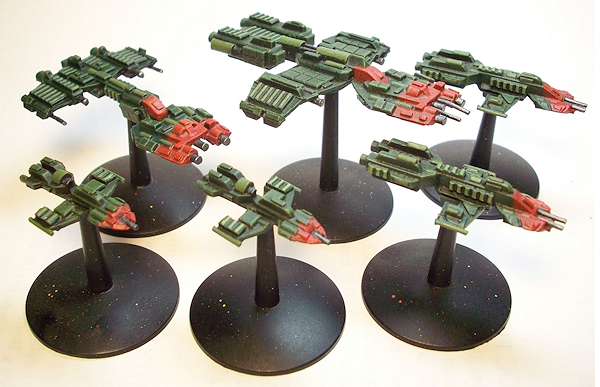 (From the GZG 2004 paper
catalog) (From the GZG 2004 paper
catalog)
The Voyenno-Kosmicheskiy Flot was formally created in 2079 with the launch
of the first Eurasian FTL warships, a few years behind the NAC. Even during
the period of Chinese domination of the ESU, up to the 2120s, most of the
operation of the VKF was along Russian lines, as China had little more than
coastal-defense navy traditions to draw on for experience. The VKF is
divided into several Sector Fleets based in different "Military
Districts", each district being made up of a number of colonies. The
Military Districts in the Core systems and Inner Worlds are relatively
small, with a single well-developed Inner Colony often being a District in
its own right, while in the Outworld possessions a single District might
encompass as many as a dozen small, far-flung outposts and settlements. The
main base for the bulk of the fleet is at the ESU Capital World of Nova
Moskva, though the Chiang Military District also has extensive base and
shipyard facilities. Many VKF personnel are conscripts, as they are in all
the ESU armed forces, though others volunteer before being conscripted in
the hope of a better career - a volunteer will generally rise through the
ranks higher and faster than a conscript. Morale on board ship is not
exactly high, out it is steady; ESU citizens are brought up to love the
Motherland, and they feel a sense of honor in protecting it. VKF crew and
officers, as in most navies, also feel that they are somewhat better than
the other armed forces such as the ground troops (though they will make an
exception for their own marines, the Naval Infantry). Conditions on board
ESU warships are mediocre at best, and are certainly not up to the standard
of NAC and FSE ships; accommodations are cramped (especially for the
ratings), food is nutritious but unappetizing, recreational facilities are
very limited or non-existent and discipline is harsh.
Ship Design Doctrine:
Most VKF ships are almost exclusively beam-armed (their superdreadnoughts
mounting some of the largest beam systems ever installed on a mobile
platform), with salvo missile systems used occasionally on a very few
classes. Ships tend to be constructed with either inherently strong hulls,
or have armour added over weaker basic construction: many classes carry
screens as a further passive defense. Mobility is average for most ships,
with some light classes being very fast but the big ships having drives of
thrust-2 or 4. The majority of the VKF's fighters are operated from
specialized carriers, but these ships generally have more offensive armament
and tougher defenses than NAC counterparts in addition to their fighter
complements. Many ESU ship designs, especially the Cruiser and small Capital
types, are optimized for long-term independent operations.
|
|
Zheng He class Scoutship
FT-232
TMF 8
NPV 28 / CPV 21
Hull 1 (1//)
Armor 1
Thrust 8
FTL
1 Fire Control
1 Class 1 Beam Battery
|
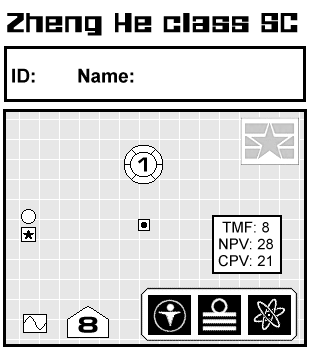 |
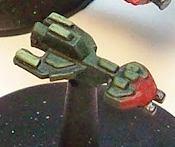 |
|
Zheng He class Scoutship:The Zheng He fleet scout
is optimized for independent long range patrol/recon missions. A large
vessel for its class, it has excellent endurance and (by ESU standards)
unusually spacious crew quarters designed to permit lengthy operations
away from resupply bases without loss of efficiency. Most commonly
encountered alone or in small groups, Zheng He’s normally attempt to
evade combat with larger vessels by employing superior acceleration and
maneuvering capacity. They are marginally more durable than the more
common Lenov class scouts, but still have little chance of surviving a
general fleet action. The only common variant is a priority courier design
which trades off the the fire control system and beam weapon for a
point-defense array and a tiny cargo hold.
|
|
Cossack class Strikeboat
FT-252
TMF 14
NPV 51 / CPV 39
Hull 1 (1//)
Armor 1
Thrust 6
FTL
1 Fire Control
1 Class 1 Beam Battery
ER Salvo Missile Rack (FP/F/FS)
|
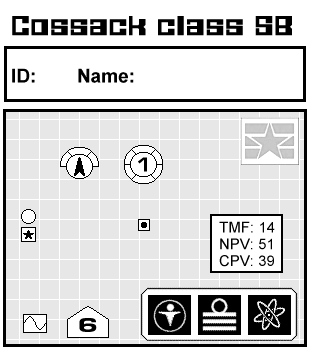 |
 |
|
Cossack class Strikeboat:
Something of an experimental design, the Cossack is a one-shot missile
platform designed to strike hard at key enemy targets. Normally fielded in
squadrons of three to twelve ships, they are equipped with the new ME-990
long range salvo missiles, allowing them to launch a punishing salvo from
beyond the range of most weapon systems. Cossacks are very fragile little
vessels, though, and their backup armament of a single dual-purpose beam
weapon is too lightweight to serve in extended engagements. Standard
practice is to withdraw after launching a massed missile volley rather
than risk almost certain destruction by staying in the fight.
|
|
Poryshkin class Corvette
FT-233
TMF 18
NPV 61 / CPV 46
Hull 4 (1/1/1/1)
Armour 1
Thrust 6
FTL
1 Fire Control
1 PDS
2 Class 2 Beam Batteries (2x FP/F/FS)
|
 |
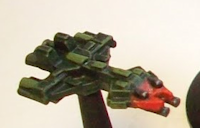 |
|
Poryshkin class Heavy Corvette: Durable,
well-armed, and fast, the Poryshkin does suffer from a relatively high
procurement cost for a corvette, as well as extremely cramped and
uncomfortable crew quarters. They are most often employed as light raider
units, or as light escorts for cruiser task forces. Poryshkins lack the
size to be truly effective in large fleet actions, but their potent
firepower commonly leads to their use in such engagements, which has
resulted in unfortunately high loss rates.
|
|
Kunitsa class Frigate
FT-234
TMF 24
NPV 80 / CPV 62
Hull 7 (2/2/2/1)
Armour 1
Thrust 6
FTL
1 Fire Control
1 PDS
2 Class 2 Beam Batteries
(FP/F/FS, All Arcs)
|
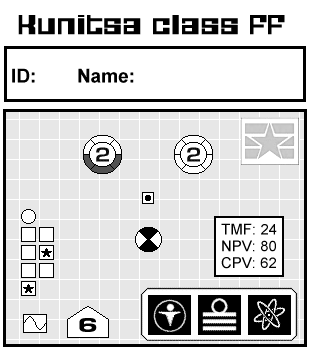 |
 |
|
Kunitsa class Frigate: A solid and well-armed
modern frigate design, the Kunitsa class is rarely seen in offensive
operations. Instead they perform a variety of police and customs duties,
provide vital convoy escorts, and act as light system patrol ships
throughout ESU territory. They are a popular duty post among enlisted
personnel, but officers regard assignment to a Kunitsa as a punishment
tour, as there is little chance of glory or promotion in such mundane
roles.
|
|
Ural class Destroyer
FT-235
TMF 34
NPV 114 / CPV 92
Hull 9 (3/2/2/2)
Armour 1
Thrust 6
FTL
1 Fire Control
1 PDS
4 Class 2 Beam Batteries
(3xFP/F/FS, All
Arcs)
|
 |
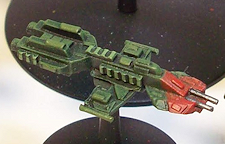 |
|
Ural class Destroyer - Fleet Variant
TMF 34
NPV 116 / CPV 94
Hull 10 (3/3/2/2)
Armour 1
Thrust 4
FTL
1 Fire Control
2 PDS
Level-1 Screens
3 Class 2 Beam Batteries
(2xFP/F/FS, All
Arcs)
|
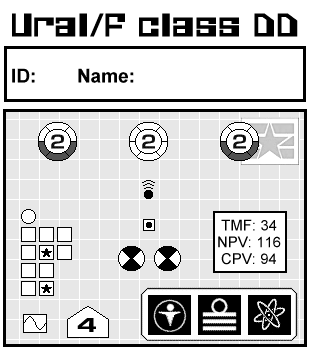 |
NOTE:
This is a "Fleet Destroyer" variant
designed to act as a close escort for capital ships, rather than for
independent action
|
|
Ural class Destroyer: Large, fast, and very
powerfully armed, the Ural class destroyers are a superb destroyer, albeit
somewhat fragile by ESU standards. Unlike older, slower destroyer designs,
they are quite capable of performing raiding or interception duties,
operating in wolfpacks of up to a dozen ships in such roles. They also act
as heavy escorts in fleet actions, with enough firepower to contribute
significantly to a cruiser squadron or capital ship’s offensive
strength. Their only real drawback is their crew accommodations, which
follow a long and unfortunate ESU tradition of being crowded and
unpleasant in the extreme.
|
|
Kunlun class Heavy Destroyer
FT-255
TMF 48
NPV 163 / CPV 138
Hull 11
(3/3/3/2)
Armour 2
Thrust 6
FTL
1 Fire Control
1 ADFC
4 PDS
4 Class 2 Beam Batteries (FP/F/FS, F/FP/AP, F/FS/AS, All
Arcs)
|
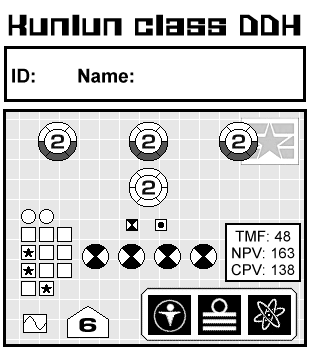 |
 |
|
Kunlun class Heavy Destroyer:
Another somewhat experimental design, the Kunlun class is the
smallest ship to carry a "Active Fleet Defense Package" (4xPDS
plus ADFC), specifically designed as a formation leader for the smaller
destroyers. Too fragile for main fleet duties, and too expensive to be
fielded in large numbers, but sometimes seen as a lightweight carrier
escort.
|
|
Kiang class Light Cruiser
FT-236
TMF 54
NPV 182 / CPV 157
Average Hull 17
(5/4/4/4)
Armor 3
Thrust 4
FTL
Level-1 Screens
2 Fire Controls
2 PDS
5 Class 2 Beam Batteries
(2xFP/F/FS, F/FP/AP, F/FS/AS, All Arcs)
|
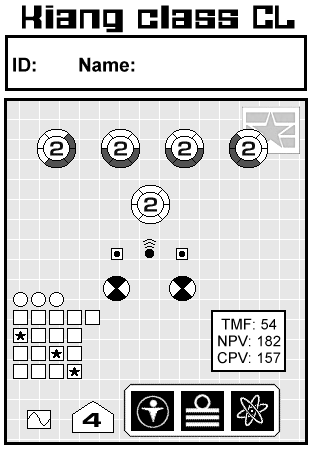 |
 |
|
Kiang class Light Cruiser: A typical light cruiser, the Kiang
design has solid structural integrity, screens, and
mid-range beam weaponry. The Kiangs are the backbone of the ESU’s new cruiser construction, and
appear in most fleet formations and cruiser squadrons.
|
|
Oriskansky class Escort Cruiser
FT-237
TMF 67
NPV 227 / CPV 205
Average Hull 21
(6/5/5/5)
Armour 4
Thrust 4
FTL
Level-1 Screens
2 Fire Controls
1 ADFC
4 PDS
5 Class 2 Beam Batteries
(2xFP/F/FS, F/FP/AP, F/FS/AS, All
Arcs)
|
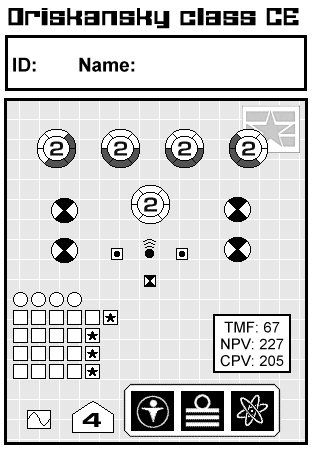 |
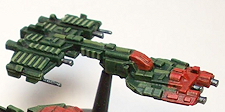 |
|
Oriskansky class Escort Cruiser:
An important part of the “New School” naval theory, the Oriskansky
class is a specialist cruiser design intended to provide area defense
coverage to smaller squadrons and non-battleline units, allowing a limited
degree of independent operations to be undertaken by the fleet’s lighter
elements. Built on an enlarged version of the Kiang light cruiser hull,
they sacrifice some firepower to carry a standard Active Fleet Defense
Package, which are otherwise found only on capital ships. These vessels
are most often found in the company of other cruisers, where they operate
in close formation as support units. They rarely accompany battleline
ships, although they can sometimes be found providing additional defensive
coverage for the lighter carrier hulls. The Oriskansky class is fairly
common but rarely found concentrated in large numbers, as they are
parceled out amongst the many light squadrons of the fleet.
|
|
Xinglong class Heavy Cruiser
FT-238
TMF 89
NPV 300 / CPV 290
Average Hull 26 (7/7/6/6)
Armour 5
Thrust 4
FTL
Level-1 Screens
2 Fire Controls
3 PDS
4 Class 2 Beam Batteries (F/FP/AP, F/FS/AS, 2xAll
Arcs)
2 Class 3 Beam Batteries (2xFP/F/FS)
|
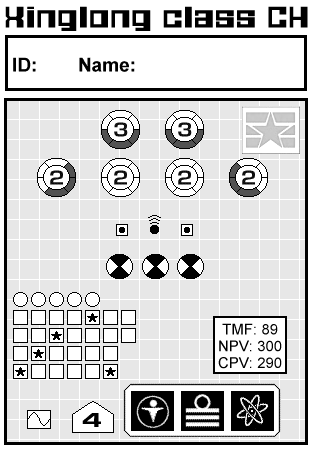 |
 |
|
Xinglong class Heavy Cruiser: One of the largest
and most powerful heavy cruisers in service in any fleet, the Xinglong is
a fair match for some light capital ships. With solid active and passive
defenses, heavy beam weaponry, and a decent turn of speed, these ships are
expensive but hard to match. They form the core of many independent
cruiser squadrons, and are also found in close support of heavier
battleline ships in larger fleets. Xinglongs are the class most often used
to “show the flag” in diplomatic missions, and are some of the most
widely-recognized ships in the ESU fleet.
|
|
Pobyeda class Battlecruiser
FT-239
TMF 107
NPV 364 / CPV 371
Average Hull 31
(8/8/8/7)
Armour 5
Thrust 4
FTL
Level-1 Screens
2 Fire Controls
1 ADFC
4 PDS
6 Class 2 Beam Batteries (2x F/FP/AP,
2x F/FS/AS, 2x All
Arcs)
2 Class 3 Beam Batteries (2xFP/F/FS)
|
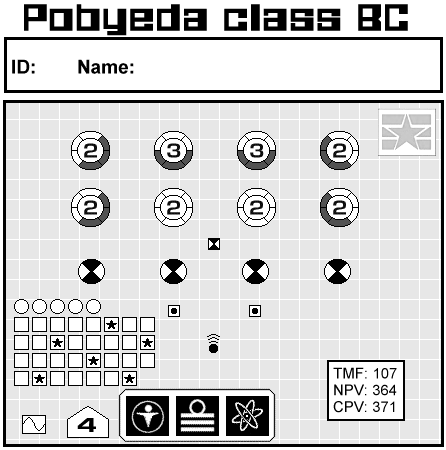 |
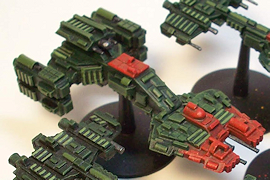 |
|
Pobyeda class Battlecruiser:
The smallest of the new construction capital ships, this battlecruiser
design shares many structural components with her larger companions in the
battleline.
Sometimes assigned to small task forces as a flagship, they are more
commonly employed in main battleline formations where they provide extra
numbers at a relatively low cost.
|
|
Khalinov class Battleship
FT-240
TMF 140
NPV 475 / CPV 531
Average Hull 42
(11/11/10/10)
Armor 6
Thrust 4
FTL
Level-1 Screens
3 Fire Controls
1 ADFC
4 PDS
4 Class 2 Beam Batteries
( F/FP/AP, F/FS/AS, 2x All
Arcs)
4 Class 3 Beam Batteries
(2xFP/F/FS, F/FP/AP, F/FS/AS)
Alternate Big
Gun Beam
Armament:
Replace the 4 Beam-3s
with 2 Beam-4s F/FP, F/FS plus 2 Beam-2s F/FP/AP, F/FS/AS
Khalinov class Battleship:
Massive and extremely durable, the Khalinov class battleships make up the
backbone of the ESU capital ship roster and appear in almost all large
fleet formations. They are expensive ships to build, but are a match and
more for any human vessel of similar mass. Khalinovs carry heavy medium
range beam armament, an Active Fleet Defense Package, moderate screens,
and a thick layer of armor over a strong basic hull
structure. Their sheer toughness has led to very few losses in combat to
date, which in turn has led to a reputation as being “lucky” ships to
serve on. |
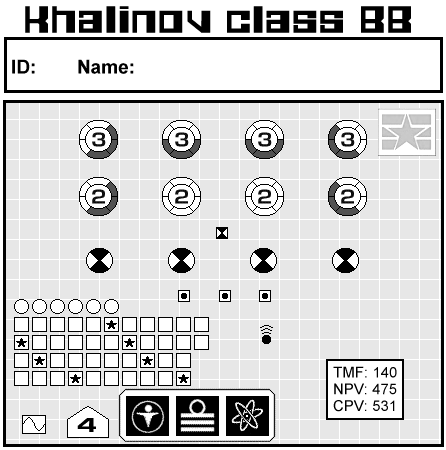

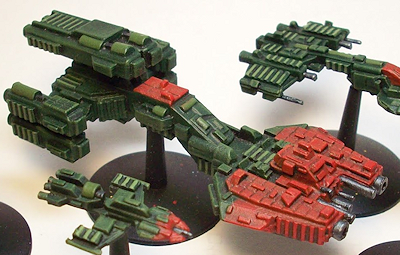 |
|
|
|
Morov class Battledreadnought
FT-241
TMF 180
NPV 609 / CPV 753
Hull 55
(14/14/14/13)
Armour 7
Thrust 4
FTL
Level- 2 Screens
3 Fire Controls
1 ADFC
4 PDS
5 Class 2 Beam Batteries
(F/FP/AP, F/FS/AS, 3x All
Arcs)
4 Class 3 Beam Batteries (2xFP/F/FS, F/FP/AP, F/FS/AS)
Alternate Big
Gun Beam
Armament:
Replace the 4 Beam-3s
with 2 Beam-4s F/FP, F/FS plus 2 Beam-2s F/FP/AP, F/FS/AS
|

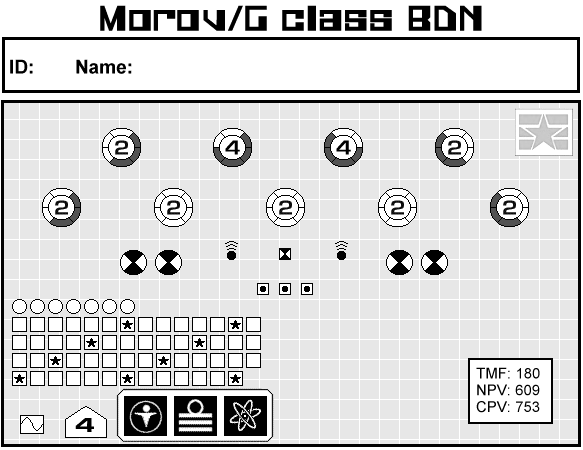
 |
|
Morov class Battledreadnought:
An improved and greatly enlarged version of the older Rostov class, the
Morov’s are more accurately termed true dreadnaughts than light or
battledreadnoughts. They possess very strong long and medium range beam
weaponry, the usual Active Fleet Defense Package, and extremely powerful
screen generators as well as a strong armored hull. Very expensive ships,
they are most commonly used as fleet flagships in larger operations. Their
only notable weakness is the lack of fighter capacity, which is sacrificed
for greater direct combat capability.
|
|
Zhukov class Superdreadnought
FT-242
TMF 242
NPV 818 / CPV
1101 + Fighters
Hull 77 (20/19/19/19)
Armour 7
Thrust 4
FTL
Level- 2 Screens
4 Fire Controls
ADFC
4 PDS
5 Class 2 Beam Batteries
( F/FP/AP, F/FS/AS, 3x All
Arcs)
5 Class 3 Beam Batteries
(FP/F/FS, 2xF/FP/AP, 2xF/FS/AS)
1 Fighter Bay
Alternate Big
Gun Beam
Armament:
Replace the Beam-3
2x F/FP/AP, 2xF/FS/AS with Beam-4s F/FP/AP, F/FS/AS
Zhukov class Superdreadnought: A long-overdue
modern superdreadnought design, the Zhukov class ships are intimidatingly
large vessels with tremendous firepower and solid defenses. They are not
quite as heavily built or gunned as the older Komarovs, but their greatly
improved thrust rating and resulting ability to operate in formation with
smaller cruiser and capital ships more than makes up for this. They are a
relatively rare design at present, but several more hulls are under
construction at the Xiang shipyards.
|
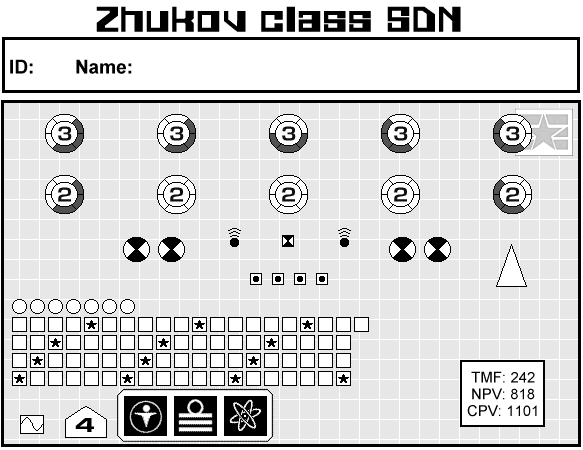
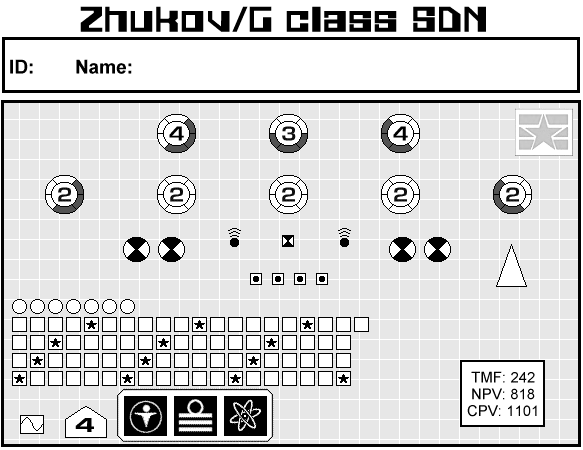
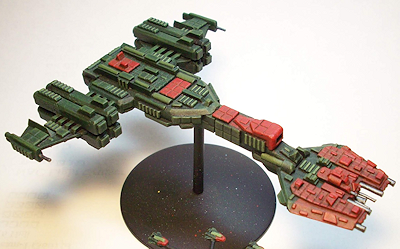 |
|
|
|
Nanjing class Escort Carrier
FT-245
TMF 104
NPV 359 / CPV
293 + Fighters
Average Hull 26
(7/7/6/6)
Armour 4
Thrust 4
FTL
Level-1 Screens
2 Fire Controls
1 ADFC
4 PDS
5 Class 2 Beam Batteries (FP/F/FS, F/FP/AP, F/FS/AS,
2xAll
Arcs)
2 Fighter Bays
|
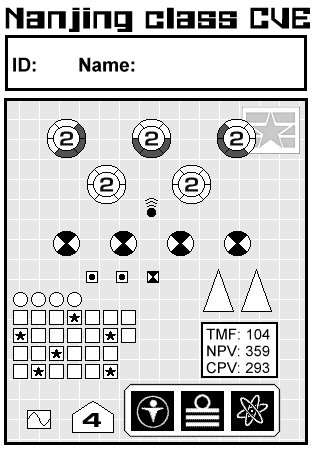 |
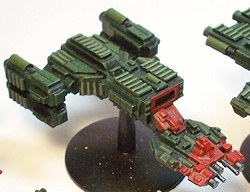 |
|
Nanjing class Escort Carrier:
Another product of the “New School” fleet architects, the Nanjing is a
small, inexpensive carrier design intended to be produced in relatively
large numbers to provide fighter support for ESU battle squadrons.
Lightly-built and carrying only a light mid-range beam armament along with
a dozen fighters, they are primarily defensive ships, avoiding the thick
of battle and using their fighters to protect other ESU ships. Like the
Oriskansky escort cruisers, they are rarely found in large numbers, as
they are more often spread out among as many formations as possible.
|
|
Changchun class Light Carrier
FT-243
TMF 182
NPV 618 / CPV
577 + Fighters
Average Hull 55
(14/14/14/13)
Armour 5
Thrust 4
FTL
Level-1 Screens
2 Fire Controls
1 ADFC
4 PDS
6 Class 2 Beam Batteries (FP/F/FS, F/FP/AP, F/FS/AS,
3xAll
Arcs)
4 Fighter Bays
Changchun class Light Carrier:
Built as a standard light carrier, the Changchun class is fairly durable
and carries two dozen fighters, but is rather lightly armed for its size.
Their fighter wings are most often used offensively, often with the
carrier and its escorts in close support. They are commonly seen in the
company of small groups of Cossack strikeboats, and coordination of
missile and fighter strikes is a primary tactical skill for ESU carrier
captains. They can also be found supporting mixed Ural/Kunlun destroyer
wolfpacks in independent operations.
|

 |
|
|
|
Shengfeng class Heavy Carrier
FT-244
TMF 289
NPV 1007 / CPV
1162 + Fighters
Average Hull 77 (20/19/19/19)
Armour 6
Thrust 3
FTL
Level-2 Screens
4 Fire Controls
1 ADFC
6 PDS
3 Class 2 Beam Batteries
(3xAll
Arcs)
5 Class 3 Beam Batteries
(FP/F/FS, 2xF/FP/AP, 2xF/FS/AS)
6 Fighter Bays
Alternate High
Thrust Version:
Thrust 4
Level-1 Screens
NPV 992 / CPV
1147 + Fighters
Alternate Big
Gun Beam
Armament:
Replace the Beam-3
2x F/FP/AP, 2xF/FS/AS with Beam-4s F/FP/AP, F/FS/AS
Shengfeng class Heavy Carrier: The Shengfeng class
heavy carrier is a powerful but inordinately expensive design, and may be
the largest spacecraft in operation in any human navy at this time. The
ship’s extreme size is actually a response to the launch of the FSE
Jeanne d’Arc supercarriers. Embarrassed by reports of the gigantic new
vessels being built by their distressingly capitalist allies, the ESU
politicos demanded an even more impressive ship from their own shipyards
to demonstrate the power of the Soviet People. The original Shengfeng
specifications called for a ship of only 23000 tons displacement, but the
final, politically-motivated version tops the scales at over 28200, an
increase of over twenty percent. The actual cost-effectiveness of the huge
Shengfengs is debatable, but they are an impressive display of industrial
and technical capacity.
|
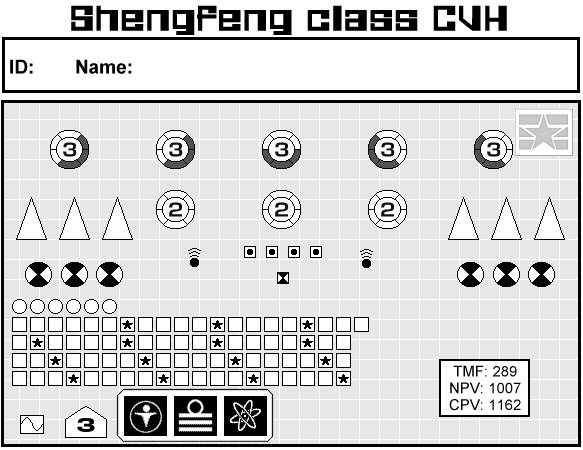 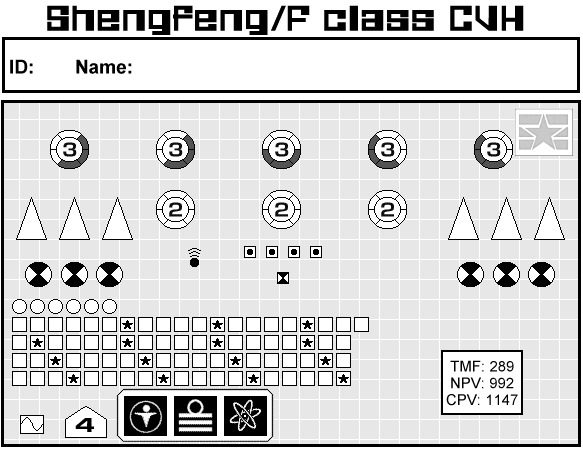
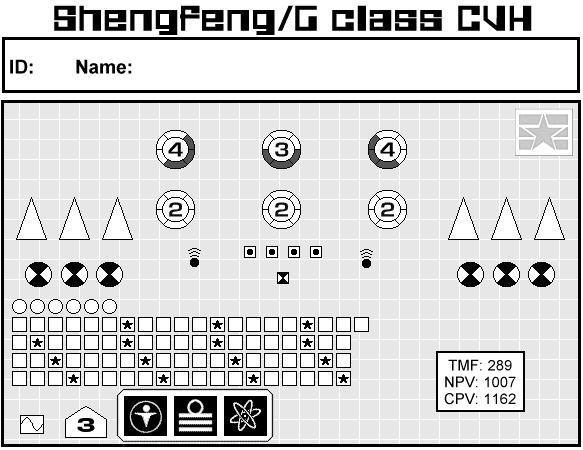
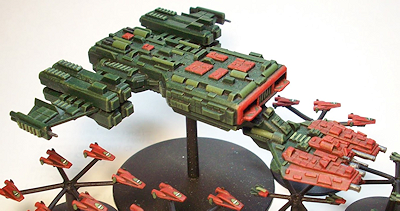 |
|
|
|
Aleksandr Tortsev class Orbital Assault
Transport (LSO)
FT-246
|
|
 |
|
Kazbek class Fleet Replenishment Tender
FT-261
|
|
 |
|
Kola class Fleet Refuelling Tanker
FT-262
|
|
 |
|
Kazbek class Fleet Replenishment Tender
(Q-ship variant)
FT-263
|
|
|
|
|
|
|